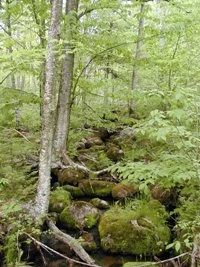Diamond Roof
No. 454

Photo by U.S. Forest Service
Diamond Roof features upland hardwoods, fast rocky creeks, mixed conifer swamps, lakes and spring ponds. The northern hardwood forest has a diverse assemblage of sugar maple, basswood, and either white ash or yellow birch. Other canopy species include paper birch, black cherry, ironwood, American elm, bitternut hickory, beech, and the uncommon butternut. Three creeks occur in the complex: Sasacat Creek, Nine Mile Creek, and McCaslin Brook which support a rare fern. The stream canopy contains common sugar maple, basswood, and white ash. Other tree species are balsam fir, yellow birch, black ash, red maple, white cedar, and hemlock.
The creeks have an occasional shrub layer, but understory trees are common. Common riparian ground layer species are lady fern, intermediate wood fern, naked miterwort, twin-leaf miterwort, and bulblet fern. Course woody debris is frequent to occasional within the creeks. Surrounding the creeks are lowland conifer swamps and a northern wet-mesic forest dominated by white cedar with black spruce, balsam fir, and yellow birch. Much of the conifer swamp contains abundant understory trees featuring branches that make passage difficult. Additional water resources include McCaslin Spring and Upper and Lower Hiwanka Lakes, both of good, undisturbed, quality. Diamond Roof is owned by the US Forest Service and was designated a State Natural Area in 2007.
Very few State Natural Areas have public facilities, but nearly all are open for a variety of recreational activities as indicated below. Generally, there are no picnic areas, restrooms, or other developments. Parking lots or designated parking areas are noted on individual SNA pages and maps. If a developed trail is present, it will usually be noted on the SNA map and/or under the Maps tab. A compass and topographic map or a GPS unit are useful tools for exploring larger, isolated SNAs.
The good majority of SNAs are isolated and have few or no facilities. Some SNAs have vehicle access lanes or parking lots, but their accessibility may vary depending on weather conditions. Parking lots and lanes are not plowed during winter. Hiking trails may be nonexistent or consist of undeveloped footpaths. A GPS unit or compass and a detailed topographic map are useful tools for exploring larger SNAs.
Non-DNR lands
Entrance fees: For non-DNR-owned SNAs, we are unaware of any vehicle or admission fees. However, please contact the landowner for more information.
Hunting and trapping
Other activities
Other allowable activities such as - but not limited to camping, geocaching and bicycling are determined by the landowner. Please contact them directly or visit their websites for details.
Location
Within the Chequamegon-Nicolet National Forest. Langlade and Oconto Counties. T33N-R14E, Sections 10-15, 21, 22, 27, 28. T33N R15E, Section 18. 1,466 acres.
Driving directions
Most of the complex is within the northeast corner of Langlade County. From the intersection of State Highway 32 and County Highway T in Townsend, go north on Highway 32 for 3.9 miles, then south and west on FR 2123 (Diamond Roof Road) for 3.3 miles to McCaslin Brook. Follow the creek west into the site. Or continue on Diamond Roof Road for another 2.8 miles, then northwest on Ada Lake Road (FR 2357) 0.9 miles to Nine Mile Creek. Follow the creek north or south into the site. A map and compass are recommended.
The DNR's state natural areas program is comprised of lands owned by the state, private conservation organizations, municipalities, other governmental agencies, educational institutions and private individuals. While the majority of SNAs are open to the public, access may vary according to individual ownership policies. Public use restrictions may apply due to public safety, or to protect endangered or threatened species or unique natural features. Lands may be temporarily closed due to specific management activities.
Users are encouraged to contact the landowner for more specific details. The data shown on these maps have been obtained from various sources, and are of varying age, reliability, and resolution. The data may contain errors or omissions and should not be interpreted as a legal representation of legal ownership boundaries. To create your custom map where you can zoom to a specific location, please use the DNR's Mapping Application.
Diamond Roof is owned by: U.S. Forest Service
